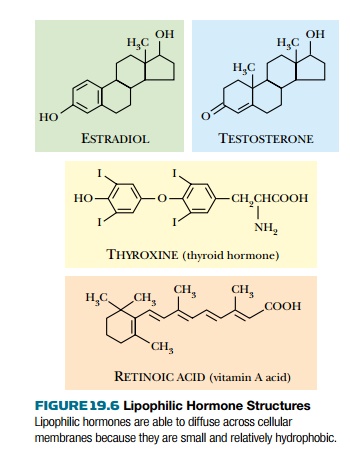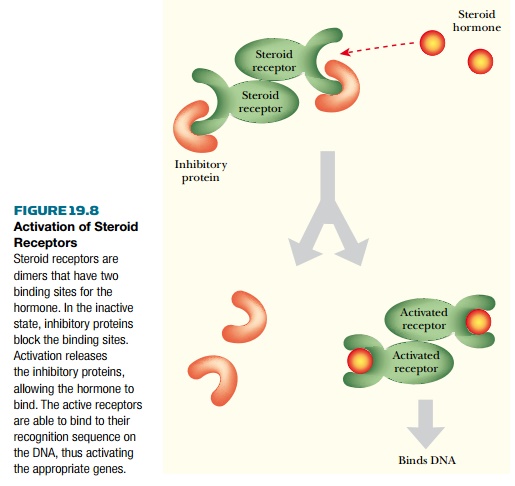Chapter: Biotechnology Applying the Genetic Revolution: Noninfectious Diseases
Steroids and Other Lipophilic Hormones
STEROIDS
AND OTHER LIPOPHILIC HORMONES
Although most hormones and pheromones
rely on binding to cell surface receptors, this is not always the case. Certain
lipophilic hormones can diffuse across the cell membrane. These include
thyroxine (thyroid hormone) , retinoic acid, and the steroid hormones ( Fig.
19.6 ). Once inside the cell, they bind to internal receptors that are soluble
proteins. Indeed, these receptors do double duty as transcription factors and
bind directly to DNA. However, because they are poorly soluble in water,
lipophilic hormones rely on carrier proteins to transport them from cell to
cell via the bloodstream. In contrast, water-soluble hormones diffuse freely through
the blood but cannot cross the cell membrane and so do not actually enter the
cell. Instead they bind to and activate receptors on the cell surface.

The receptors for the
lipophilic hormones belong to the nuclear-receptor superfamily of proteins (
Fig. 19.7 ). They all act as transcription factors in addition to hormone
receptors and bind to recognition sequences in the DNA of the upstream region
of their target genes. They may be subdivided into two classes:
(a) Most steroid receptors , such as the estrogen receptor or glucocorticoid
receptor, are found in the cytoplasm. After binding the steroid, they enter the
nucleus ( Fig. 19.8 ). These receptors form dimers that recognize inverted
repeats of 6 bp in the DNA.


(b) The receptors for androgens, vitamin D
(a steroid), thyroxine, and retinoic acid are permanently located in the
nucleus. Apparently, the hormones migrate via the intracellular membranes to
the nuclear membrane and join their receptors inside the nucleus. These
receptors bind to the related RXR protein to form mixed dimers (see Fig. 19.7
). These recognize direct repeats of 6 base pairs in the DNA. The same
6 base-pair sequence may be
recognized by different receptors; however, in this case the spacing between
the 6 base-pair repeats differs.
Industrial pollution has
contaminated the environment with a variety of polycyclic molecules resembling
steroids, to a greater or lesser extent. These may enter the body (via
ingestion or through the skin) and can diffuse through membranes due to their
lipophilic nature. Some of these, known as xenoestrogens , bind to steroid receptors
and mimic the action of estrogens. This may cause reproductive problems or
promote cancer of the uterus. It has even been suggested that the major drop in
sperm counts seen over the past half century in the industrial nations,
especially the United States, may be due to such estrogen mimics, though this
remains speculative.
Related Topics